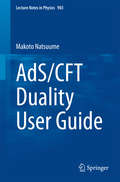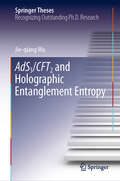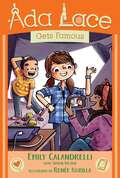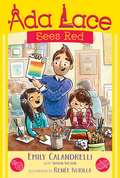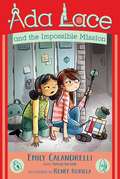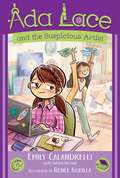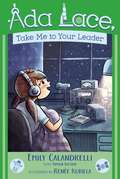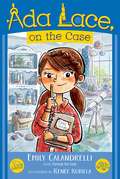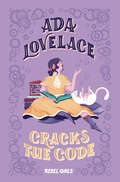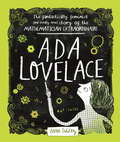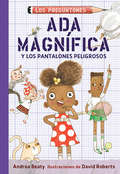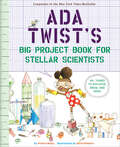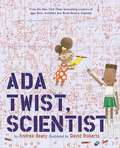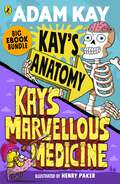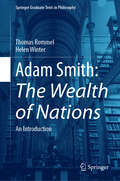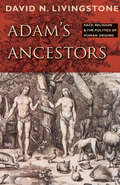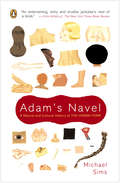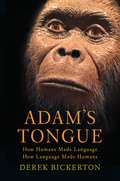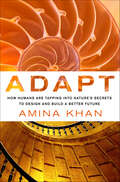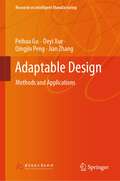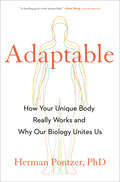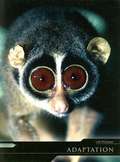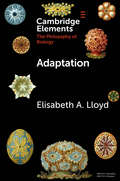- Table View
- List View
AdS/CFT Duality User Guide (Lecture Notes in Physics #903)
by Makoto NatsuumeThis book describes applications of the AdS/CFT duality to the "real world. " The AdS/CFT duality is an idea that originated from string theory and is a powerful tool for analyzing strongly-coupled gauge theories using classical gravitational theories. In recent years, it has been shown that one prediction of AdS/CFT is indeed close to the experimental result of the real quark-gluon plasma. Since then, the AdS/CFT duality has been applied to various fields of physics; examples are QCD, nuclear physics, condensed-matter physics, and nonequilibrium physics. The aim of this book is to provide background materials such as string theory, black holes, nuclear physics, condensed-matter physics, and nonequilibrium physics as well as key applications of the AdS/CFT duality in a single volume. The emphasis throughout the book is on a pedagogical and intuitive approach focusing on the underlying physical concepts. It also includes step-by-step computations for important results, which are useful for beginners. This book will be a valuable reference work for graduate students and researchers in particle physics, general relativity, nuclear physics, nonequilibrium physics, and condensed-matter physics.
AdS3/CFT2 and Holographic Entanglement Entropy (Springer Theses)
by Jie-qiang WuThis book focuses on AdS3/CFT2, addressing different aspects of this correspondence in field theory and in gravity, including entanglement entropy, higher genus partition function, and conformal block. Holographic entanglement entropy is an important area in holographic and quantum information, which implies a deep relation between geometry and quantum entanglement. In this book, the authors use holographic entanglement entropy as a tool to investigate AdS3/CFT2. They study the entanglement entropy at high temperature in field theory and in holographics, and show that the results match each other in classical and one-loop order. In the AdS3/CFT2 system, they examine in detail the correspondence, exploring the higher genus partition function, entanglement entropy in a general system and conformal block, and they find good correspondence in field theory and gravity. The result strongly supports AdS3/CFT2 correspondence. In addition, they develop several important techniques in 2d CFT and 3d gravity, which also offer inspiration for other fields.
Ada Lace Gets Famous (An Ada Lace Adventure #6)
by Emily CalandrelliFrom Emily Calandrelli—Emmy-nominated host of Xploration Outer Space, host of Netflix&’s Emily&’s Wonder Lab, and graduate of MIT—comes the sixth novel in a fun illustrated chapter book series about an eight-year-old girl with a knack for science, math, and solving mysteries with technology.When third grader and inventor extraordinaire Ada Lace learns her teachers are in dire need of new school supplies, she&’s eager to lend a helping hand—but how? With a bake sale? A class carnival? Most ideas seem out of reach for a kid like her, until Tycho suggests Ada try her hand at posting informational videos. If she&’s able to build up a big online viewership, she could easily raise funds for their school. And with Nina as her visionary director, Milton as her comedic cohost, and Ada as the scientist star, making fun videos will be a piece of cake! Or so they think. What starts as an earnest try at making fun, science-based shorts ends up being a whole mess for Ada and the gang as they gain popularity and take on peer pressure, trolls, and tests of their friendships. With her rising internet stardom, will Ada be able to stay true to herself?
Ada Lace Sees Red
by Emily Calandrelli Renée Kurilla Tamson WestonFrom Emily Calandrelli—host of Xploration Outer Space, correspondent on Bill Nye Saves the World, and graduate of MIT—comes the second novel in a brand-new chapter book series about an eight-year-old girl with a knack for science, math, and solving mysteries with technology.Ada Lace is building a new robot! She’s determined to beat Milton in the upcoming robotics competition. But she’s distracted—Ada finds her dad’s art class impossible, while Nina is the star of the class, basking in the glory of being Mr. Lace’s star pupil. When Mr. Lace suggests that Nina put on an art show, Ada becomes jealous and loses her temper. Now Ada isn’t speaking to her dad, she’s falling behind in art class, and she still doesn’t know how to fix her robot. As the competition looms closer, Ada starts to wonder if there might be a way to use both science and art to solve her problems. Will Ada make up with her father in time to test her hypothesis? Or will her hurt feelings leave her seeing red and without a medal at the end of the day?
Ada Lace and the Impossible Mission: Ada Lace, On The Case; Ada Lace Sees Red; Ada Lace, Take Me To Your Leader; Ada Lace And The Impossible Mission (An Ada Lace Adventure #4)
by Emily Calandrelli Renée Kurilla Tamson WestonFrom Emily Calandrelli—Emmy-nominated host of Xploration Outer Space, correspondent on Bill Nye Saves the World, and graduate of MIT—comes the fourth novel in a fun illustrated chapter book series about an eight-year-old girl with a knack for science, math, and solving mysteries with technology.Third grader and inventor extraordinaire Ada Lace has a new social studies teacher—who loves group projects. While most of the class has constructed regular dioramas with clay and construction paper, Ada, her best friend Nina, and sometimes nemesis Milton have built a complex scale model of an historic silver mine. But when Milton reveals that he added his “old Milton touch” on their project right before turning it in, Ada worries that he has sabotaged their work. In a desperate attempt to save their project, Ada and Nina use their combined creative and technical prowess to perform a heist and break into their teacher’s supply closet after school. Do the two friends have what it takes to deceive the school’s security system? Or will they get caught trying to pull off this seemingly impossible mission.
Ada Lace and the Suspicious Artist (An Ada Lace Adventure #5)
by Emily Calandrelli Renée Kurilla Tamson WestonFrom Emily Calandrelli—Emmy-nominated host of Xploration Outer Space, correspondent on Bill Nye Saves the World, and graduate of MIT—comes the fifth novel in a fun illustrated chapter book series about an eight-year-old girl with a knack for science, math, and solving mysteries with technology.Third grader and inventor extraordinaire Ada Lace is on spring break. But it’s just a little less relaxing than she’d imagined. Nina is beside herself with excitement about meeting her favorite artist and enlists Ada and Mr. Peebles’s coding-whiz nephew to help revamp her online portfolio. When Nina finally meets Miroir, he snubs her, and her confidence is shaken—but not enough to miss the art show opening. While there, Ada spots a suspiciously familiar painting that may mean Miroir isn’t the original he claims to be. Will the friends be able to reveal the artist’s true nature, before he fools someone else?
Ada Lace, Take Me to Your Leader: Ada Lace, On The Case; Ada Lace Sees Red; Ada Lace, Take Me To Your Leader; Ada Lace And The Impossible Mission (An Ada Lace Adventure #3)
by Emily Calandrelli Renée Kurilla Tamson WestonFrom Emily Calandrelli—host of Xploration Outer Space, correspondent on Bill Nye Saves the World, and graduate of MIT—comes the third novel in a fun illustrated chapter book series about an eight-year-old girl with a knack for science, math, and solving mysteries with technology.Third grader and inventor extraordinaire Ada Lace likes nothing more than to tinker with mechanics like her robot, George. Her latest project is to fix up a ham radio, something that she could use to contact people on this planet…and beyond. The only problem is that she just can’t get it to work properly. During a sleepover, Ada’s best friend Nina hears something strange coming from the radio in the middle of the night. A distant voice says, “Release the swarm!” convincing Nina that aliens are about to invade planet Earth. Could Ada and Nina have stumbled upon something…extraterrestrial?
Ada Lace, on the Case (An Ada Lace Adventure #1)
by Emily CalandrelliFrom Emily Calandrelli—host of Xploration Outer Space, correspondent on Bill Nye Saves the World, and graduate of MIT—comes the first novel in a brand-new chapter book series about an eight-year-old girl with a knack for science, math, and solving mysteries with technology.Ada Lace—third-grade scientist and inventor extraordinaire—has discovered something awful: her neighbor&’s beloved Yorkie has been dognapped! With the assistance of a quirky neighbor named Nina (who is convinced an alien took the doggie) and her ever-growing collection of gadgets, Ada sets out to find the wrongdoer. As their investigation becomes more and more mysterious, Ada and Nina grow closer, proving that opposites do, in fact, attract.
Ada Lovelace
by Diane Stanley Jessie Hartland“A fascinating look at Ada Lovelace, the pioneering computer programmer and daughter of the poet Lord Byron."
Ada Lovelace Cracks the Code (Rebel Girls Chapter Books)
by Rebel Girls Corinne PurtillFrom the world of Good Night Stories for Rebel Girls comes a story based on the exciting real-life adventures of Ada Lovelace, one of the world's first computer programmers.Growing up in nineteenth century London, England, Ada is curious about absolutely everything. She is obsessed with machines and with creatures that fly. She even designs her own flying laboratory!According to her mother, Ada is a bit too wild, so she encourages Ada to study math. At first Ada thinks: Bleh! Who can get excited about a subject without pictures? But she soon falls in love with it. One day she encounters a mysterious machine, and from that moment forward Ada imagines a future full of possibility-one that will eventually inspire the digital age nearly two hundred years later.Ada Lovelace Cracks the Code is the story of a pioneer in the computer sciences, and a testament to women's invaluable contributions to STEM throughout history.This historical fiction chapter book also includes additional text on Ada Lovelace's lasting legacy, as well as educational activities designed to teach simple coding and mathematical concepts.About the Rebel Girls Chapter Book SeriesMeet extraordinary real-life heroines in the Good Night Stories for Rebel Girls chapter book series! Introducing stories based on the lives and times of extraordinary women in global history, each stunningly designed chapter book features beautiful illustrations from a female artist as well as bonus activities in the backmatter to encourage kids to explore the various fields in which each of these women thrived. The perfect gift to inspire any young reader!
Ada Lovelace: The Fantastically Feminist (and Totally True) Story of the Mathematician Extraordinaire
by Anna DohertyAn inspiring, empowering, fantastically feminist and totally true story, perfect for fans of Little People, Big Dreams and Goodnight Stories for Rebel Girls! Meet the remarkable Ada Lovelace: rebellious rule-breaker and maths whizz-kid. Growing up in the shadow of her eccentric superstar father, the poet Lord Byron, and under the eye of her strict mother, Ada spends her time inventing and designing flying machines and studying her favourite subject - maths. In Ada's time, girls aren't encouraged to pursue maths, physics or engineering as they're considered not clever enough but Ada doesn't let this stop her. Once she grows up, Ada meets the famous inventor and engineer Charles Babbage, who introduces her to a truly extraordinary machine ... one that will test Ada's powers of logic and imagination, and establish her as the world'd very first computer programmer!This is the absolutely astonishing, fantastically feminist and, best of all, totally true story of one amazingly determined young lady!
Ada Magnífica y los pnatalones peligrosos
by BEATY, ANDREA / ROBERTS,DAVID«¡Bestseller del New York Times! Continúan las aventuras de los Preguntones: Rosa Pionera, Ada Magnífica y Pedro Perfecto. En esta segunda entrega, Ada Magnífica deberá confiar en su mente curiosa y en sus amigos, Rosa y Pedro, para resolver un misterio en su propio vecindario. Ada Magnífica es la reina de las preguntas. Científica de corazón, Ada pregunta por qué una y otra vez. Una pregunta siempre lleva a otra, hasta que se embarca en un viaje de descubrimiento. Cuando el viento se lleva a Ned, el tío de Rosa Pionera, con sus famosos pantalones de helio, depende de Ada y sus amigos salvarlo. Mientras el tío Ned flota más y más lejos, Ada comienza a hacer muchas preguntas. ¿Qué tan alto puede volar el tío Ned? ¿Subirá volando hasta el espacio? Y, lo más importante: ¿cómo pueden bajarlo?
Ada Twist's Big Project Book for Stellar Scientists: 40+ Things to Discover, Draw, and Make (The Questioneers)
by Andrea BeatyAlong the way, Ada Twist will help her fellow young scientists solve mysteries big and small and show how the powerful impact of scientific research is felt all around us. Do you ask questions? Is why your favorite word? Do you like to search for answers and conduct experiments? Then you’re a scientist, just like Ada Twist, and this book is for you! Here young scientists have the opportunity to explore all of Ada’s favorite sciences—from botany to astronomy to chemistry, and everything in between. They’ll create experiments, follow the scientific method, and learn to look more closely at the world around them. Track the phases of the moon Build an aquascope Grow plants in your own garden Watch decomposition at work Record weather changes Observe a chemical reaction Design a vehicle powered by renewable energy And much more! For any parent who wants STEM (Science, Technology, Engineering, and Math) to be fun for their girl or boy, this book is packed with experiments and activities designed to inspire children to be excited about science, school, and learning.
Ada Twist, Scientist
by David Roberts Andrea BeatyLike her classmates, builder Iggy and inventor Rosie, scientist Ada, a character of color, has a boundless imagination and has always been hopelessly curious. Why are there pointy things stuck to a rose? Why are there hairs growing inside your nose? When her house fills with a horrific, toe-curling smell, Ada knows it’s up to her to find the source. What would you do with a problem like this? Not afraid of failure, Ada embarks on a fact-finding mission and conducts scientific experiments, all in the name of discovery. But, this time, her experiments lead to even more stink and get her into trouble! Inspired by real-life makers such as Ada Lovelace and Marie Curie, Ada Twist, Scientist champions girl power and women scientists, and brings welcome diversity to picture books about girls in science. Touching on themes of never giving up and problem solving, Ada comes to learn that her questions might not always lead to answers, but rather to more questions. She may never find the source of the stink, but with a supportive family and the space to figure it out, she’ll be able to feed her curiosity in the ways a young scientist should.
Adam Kay Bundle
by Adam KayLearn all about the human body with this bundle of Kay's Anatomy and Kay's Marvellous Medicine from bestselling author, Adam Kay.From what's going on inside our bodies, to when and why we discovered how our insides actually work, Adam Kay has every (slimy and smelly) detail covered!In Kay's Anatomy you'll find out: Why your skin gets wrinkly in the bathWhether bogies are safe to eatHow much of your life you will spend on the toiletAnd loads more fascinating facts you can wow (and horrify) your parents and teachers with. In Kay's Marvellous Medicine, travel back in time and find out why:Doctors made patients gargle with weeA washing machine, a can of beans and some sausages helped save livesAncient Romans ate lying down You won't believe the wacky ideas people had back in those days.So, if you can handle the pus and the snot, step into the weird and wonderful world of the human body with Adam Kay!Praise for Adam Kay:'Will delight, gross out and educate all at the same time' Independent'Totally brilliant!' Jacqueline Wilson
Adam Smith: An Introduction (Springer Graduate Texts in Philosophy)
by Helen Winter Thomas RommelThis textbook provides an accessible introduction to Adam Smith, one of the most important economic thinkers. His seminal work The Wealth of Nations is a classic text in philosophy, social sciences and economics. This introduction puts Smith&’s central ideas on the division of labour, the invisible hand and the market into context. A careful analysis of key passages from Smith&’s writings explains how he arrived at a theory of society and the market that has become central to our understanding of human motives. The discussion of Smith&’s The Wealth of Nations is followed by sources from the 18th century that shaped Smith&’s analysis of human motives and propensities. This introduction is indispensable reading for an informed discussion of the mechanisms that govern human society. It provides an introduction to Adam Smith as one of the most astute thinkers of the 18th century, whose ideas shape modern concepts of the market, making it ideal as course material in courses such as economics, history, political sciences, sociology, literary studies, philosophy.
Adam's Ancestors: Race, Religion, and the Politics of Human Origins (Medicine, Science, and Religion in Historical Context)
by David N. LivingstoneWinner of the Selection for Professional Reading List of the U.S. Marine CorpsAlthough the idea that all human beings are descended from Adam is a long-standing conviction in the West, another version of this narrative exists: human beings inhabited the Earth before, or alongside, Adam, and their descendants still occupy the planet.In this engaging and provocative work, David N. Livingstone traces the history of the idea of non-adamic humanity, and the debates surrounding it, from the Middle Ages to the present day. From a multidisciplinary perspective, Livingstone examines how this alternative idea has been used for cultural, religious, and political purposes. He reveals how what began as biblical criticism became a theological apologetic to reconcile religion with science—evolution in particular—and was later used to support arguments for white supremacy and segregation. From heresy to orthodoxy, from radicalism to conservatism, from humanitarianism to racism, Adam's Ancestors tells an intriguing tale of twists and turns in the cultural politics surrounding the age-old question, "Where did we come from?"
Adam's Navel
by Michael SimsIn this amusing and brilliantly conceived book, Michael Sims introduces you to your body. Moving from head to toe, Sims blends cultural history with evolutionary theory to produce a wonderfully original narrative in which he analyzes the visible parts of the body. In this fascinating brew of science and storytelling, readers encounter not only accessible explanations of the mechanics of their anatomy, but also the layers of mythology, religious lore, history, Darwinian theory, and popular culture that have helped to shape our understanding of any given body part. A titillating and unique book, Adam’s Navel is learned and entertaining, a marvelous lens through which to study the form we all inhabit—but may not really understand. .
Adam's Tongue: How Humans Made Language, How Language Made Humans
by Derek BickertonHow language evolved has been called "the hardest problem in science. " In Adam's Tongue, Derek Bickerton--long a leading authority in this field--shows how and why previous attempts to solve that problem have fallen short. Taking cues from topics as diverse as the foraging strategies of ants, the distribution of large prehistoric herbivores, and the construction of ecological niches, Bickerton produces a dazzling new alternative to the conventional wisdom. Language is unique to humans, but it isn't the only thing that sets us apart from other species--our cognitive powers are qualitatively different. So could there be two separate discontinuities between humans and the rest of nature? No, says Bickerton; he shows how the mere possession of symbolic units--words--automatically opened a new and different cognitive universe, one that yielded novel innovations ranging from barbed arrowheads to the Apollo spacecraft. Written in Bickerton's lucid and irreverent style, this book is the first to thoroughly integrate the story of how language evolved with the story of how humans evolved. Sure to be controversial, it will make indispensable reading both for experts in the field and for every reader who has ever wondered how a species as remarkable as ours could have come into existence. '
Adapt: How Humans Are Tapping into Nature's Secrets to Design and Build a Better Future
by Amina KhanAmina Khan believes that nature does it best. In Adapt, she presents fascinating examples of how nature effortlessly solves the problems that humans attempt to solve with decades worth of the latest and greatest technologies, time, and money. Humans are animals too, and animals are incredibly good at doing more with less. If a fly’s eye can see without hundreds of fancy lenses, and termite mounds can stay cool in the desert without air conditioning, it stands to reason that nature can teach us a thing or two about sustainable technology and innovation. In Khan’s accessible voice, these complex concepts are made simple. There is so much we humans can learn from nature’s billions of years of productive and efficient evolutionary experience. This field is growing rapidly and everyone from architects to biologists to nano-technicians to engineers are paying attention. Results from the simplest tasks, creating Velcro to mimic the sticking power of a burr, to the more complex like maximizing wind power by arranging farms to imitate schools of fish can make a difference and inspire future technological breakthroughs.Adapt shares the weird and wonderful ways that nature has been working smarter and not harder, and how we can too to make billion dollar cross-industrial advances in the very near future.
Adaptable Design: Methods and Applications (Research on Intelligent Manufacturing)
by Jian Zhang Peihua Gu Deyi Xue Qingjin PengThis book provides a comprehensive discussion of Adaptable Design (AD). It covers the conception, method, and application of AD to the real-world product design. AD's benefits are substantial as it upgrades, reuses, remanufactures and recycles products throughout the product lifecycle. It rapidly adapts the existing design in development of new designs. Key elements of AD include rationalized function structures, adaptable product architectures, adaptable interfaces, and adaptability evaluations. The main feature of AD is adaptability in design methods and product applications with general and specific adaptability. AD has also modeling and evaluating adaptabilities.
Adaptable: How Your Unique Body Really Works and Why Our Biology Unites Us
by Herman Pontzer PhDA new understanding of how our bodies work, how to keep them healthy, and how our biological diversity unites us rather than divides usHow does the body work—and why does it seem to work so differently for each of us? Why do we grow tall or short, obese or slim? Why do some of us stay healthy despite our bad habits while others who do all the right things fall ill? When we look around the planet, why do people vary in skin color, facial features, stature, body proportions, and disease risk? The answer is both simple and powerful: We&’re different because we&’re adaptable. Over the past 100,000 years, as humans expanded into every biome on the planet, our bodies were fine-tuned to our local environments. Adaptability is at the heart of being human and the engine of our diversity – our species&’ original superpower. As an evolutionary anthropologist working with human populations around the globe, Herman Pontzer has conducted research that embraces our incredible diversity, documenting the connections among lifestyle, landscape, local adaptations, and health. Adaptable takes us on a tour of the human body. In each chapter, we learn how our bodies navigate an uncertain world: how we grow and mature; how our brains develop and learn; how our hearts, lungs, and digestive systems deliver oxygen and nutrients; how we manage toxins, temperature, and water balance; how we move and reproduce; how our immune system keeps invaders at bay; and how we age and decline. Along the way, we learn how to take care of our remarkable bodies, and that the universe of healthy lifestyles is vast (we don&’t need the latest fad diet or cleanse!). Crucially, we come to see how understanding our bodies helps us make sense of the big issues we face today, from vaccines to heart disease, IQ to athletic excellence, diets and obesity to sex and gender, and what we can do to live longer and healthier.
Adaptation
by Steve ParkerDiscover how living things adapt to the world around them, creating millions of different species. Explore the fascinating world of living things, including the processes that keep animals and plants alive, and how people study them. Fact boxes that introduce the most amazing plants and animals are featured in this book along with colorful photographs that show the incredible diversity of life. This book includes a glossary and resources for further research. New edition ISBN: 1403488436 (hardcover)
Adaptation (Elements in the Philosophy of Biology)
by Elisabeth LloydNatural selection causes adaptation, the fit between an organism and its environment. For example, the white and grey coloration of snowy owls living and breeding around the Arctic Circle provides camouflage from both predators and prey. In this Element, we explore a variety of such outcomes of the evolutionary process, including both adaptations and alternatives to adaptations, such as nonadaptive traits inherited from ancestors. We also explore how the concept of adaptation is used in evolutionary psychology and in animal behavior, and the adequacy of methods used to confirm evolutionary accounts of human traits and behaviors.
Adaptation and Change On the Galapagos Islands
by Helen Sillett"The vampire finch and the sneaker iguana have something in common. They both live on the Galapagos Islands, a group of islands in the Pacific Ocean. These islands are a natural wonderland full of strange and amazing birds and animals. Some people have heard about the Galapagos because of the giant tortoises (turtles) that live there. Maybe you have seen these animals in a book or on television. The Galapagos Islands are also famous because of a young man named Charles Darwin, who visited them in 1835. Later, Darwin went on to become one of the most important scientists the world has ever known."-Introduction
